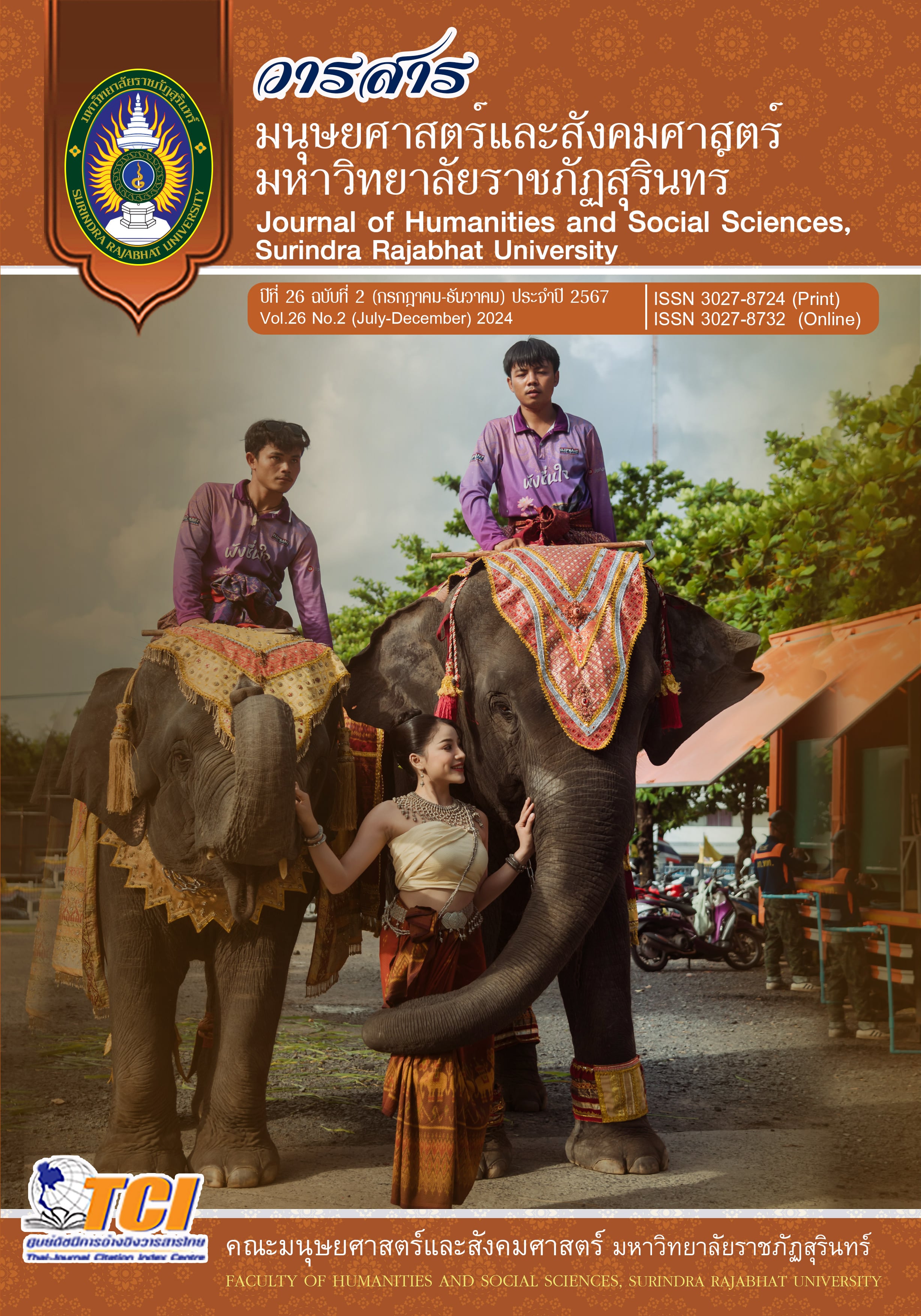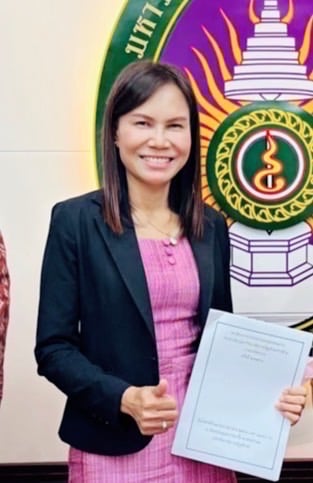ศึกษาหลักพุทธธรรมที่ปรากฏในพิธีกรรมแกลมอของชุมชนในตำบลตรึมอำเภอศีขรภูมิ จังหวัดสุรินทร์
คำสำคัญ:
พิธีกรรมแกลมอ, หลักพุทธธรรม, วิเคราะห์หลักพุทธธรรมบทคัดย่อ
การวิจัยนี้มีวัตถุประสงค์เพื่อ 1) ศึกษาพิธีกรรมแกลมอของชุมชนในเขตตำบลตรึม อำเภอศีขรภูมิ จังหวัดสุรินทร์ 2) ศึกษาหลักพุทธธรรมที่ปรากฏในพิธีกรรมแกลมอของชุมชนในตำบลตรึม อำเภอศีขรภูมิ จังหวัดสุรินทร์ และ 3) วิเคราะห์หลักพุทธธรรมที่ปรากฎในพิธีกรรมแกลมอของชุมชนในเขตตำบลตรึม อำเภอศีขรภูมิ จังหวัดสุรินทร์ เป็นการวิจัยเชิงคุณภาพภาคสนาม โดยการลงพื้นที่เก็บข้อมูลสัมภาษณ์เชิงลึก วิเคราะห์ข้อมูลด้วยวิธีพรรณนา
ผลการวิจัยพบว่า พิธีกรรมแกลมอ เป็นประเพณีของท้องถิ่นชุมชนในตำบลตรึม ภาษาถิ่นเรียกว่าเล่นมอ (แกลมอ ) ชาวบ้านประกอบพิธีกรรมนี้เพื่อให้กำลังใจคนที่เจ็บป่วยหรือมีทุกข์ทางใจ พิธีแกลมอจะมีอยู่ 3 ประเภท คือ 1) การบูชาดวงวิญญาณบรรพบุรุษเพื่อเป็นการสร้างขวัญกำลังใจ 2) การประกอบพิธีกรรมเพื่อรักษาผู้ป่วยซึ่งเป็นการอัญเชิญดวงวิญญาณของบรรพบุรุษมาให้ความช่วยเหลือ ขอคำแนะนำผ่านล่าม หรือ คนทรงเพื่อหาสาเหตุของการเจ็บป่วยและหาทางรักษาตามความเชื่อ 3) การประกอบพิธีกรรมเพื่อเป็นการแก้บนหรือสักการะตอบแทนดวงวิญญาณบรรพบุรุษที่ดลบันดาลให้ได้รับความสำเร็จตามคำขอของลูกหลาน หลักพุทธธรรมที่ปรากฏในพิธีกรรมแกลมอ คือ หลักศรัทธา ภูตะ วิญญาณ กตัญญูกตเวที โรค การเคารพ บูชา กรรม บุญกิริยาวัตถุ ไตรลักษณ์ และฆราวาสธรรม ผลการวิเคราะห์หลักพุทธธรรมที่ปรากฏในพิธีกรรมแกลมอ คือ 1) หลักศรัทธา คือ มีความเชื่อว่าถ้าไม่ทำพิธีกรรม สมาชิกในครอบครัวอาจเจ็บป่วยมีความทุกข์ทางใจได้ 2) ภูตะ คือ ผีหรือวิญญาณบรรพบุรุษ ที่อาศัยอยู่ตามบ้านเรือน ตามทุ่งนา 3) วิญญาณ คือ เป็นการสื่อสารกับวิญญาณบรรพบุรุษ 4) กตัญญูกตเวที คือ เป็นการแสดงออกเพื่อตอบแทนคุณบรรพบุรุษ 5) โรค คือ โรคที่รักษาหายและไม่หาย 6) การเคารพ คือ เป็นแนวทางที่ต้องปฏิบัติต่อครูบา 7) บูชา คือ เป็นสิ่งแทนการบูชาในพิธี 8) กรรม คือ เป็นการสอนเชื่อเรื่องกรรมที่มาจากวิญญาณบรรพบุรุษเป็นหลัก 9) บุญกิริยาวัตถุ คือ มีการให้ทาน รับศีล และเจริญภาวนา 10) ไตรลักษณ์ คือ ให้เห็นว่าร่างกายและความเป็นไปของชีวิตมนุษย์ตกอยู่ในหลักไตรลักษณ์ และ 11) ฆราวาสธรรม คือ ปลูกฝังให้มีสัจจะ ข่มจิตใจ ความอดทน และมีการเสียสละ
Downloads
References
พระเทพวิสุทธิเมธี (ปัญญานันทภิกขุ). (2536). กตัญญูกตเวที เป็นเครื่องหมายของคนดี. กรุงเทพฯ : ธรรมสภา.
พระธรรมกิตติวงศ์ (ทองดี สุรเตโช). (2553). หนังสือพจนานุกรมเพื่อการศึกษาพุทธศาสน์. กรุงเทพฯ : ธรรมสภาและสถาบันบันลือธรรม.
พระพรหมคุณาภรณ์ (ป. อ. ปยุตฺโต). (2552). พจนานุกรมพุทธศาสตร์ ฉบับประมวลธรรม. กรุงเทพฯ : จันทร์เพ็ญ.
พระมหาสมปอง มุทิโต. (2542). คัมภีร์อภิธานวรรณนา. กรุงเทพฯ : โรงพิมพ์ธรรมสภา.
พระมหาสมศักดิ์ คมฺภีรปญฺโญ (ตัวไธสง). (2561). ศึกษาหลักธรรมที่ปรากฏในพิธีกรรมแกลมอของหมู่บ้านแสนสุข ตำบลห้วยแถลง อำเภอห้วยแถลง จังหวัดนครราชสีมา. วิทยานิพนธ์พุทธศาสตรมหาบัณฑิต บัณฑิตวิทยาลัย มหาวิทยาลัยมหาจุฬาลงกรณราชวิทยาลัย.
พระศรีคัมภีรญาณ (สมจินต์ วันจันทร์). (2559). จริยศาสตร์ในคัมภีร์พระพุทธศาสนา. พระนครศรีอยุธยา : มหาวิทยาลัยมหาจุฬาลงกรณราชวิทยาลัย.
พุทธทาสภิกขุ (เงื่อม อินทปญฺโญ). (2553). ธรรมโฆษณ์อรรถานุกรม. กรุงเทพฯ : สวนอุดมมูลนิธิ.
__________. (2545). ท่านพุทธทาสกับการศึกษา. กรุงเทพฯ : โรงพิมพ์คุรุสภา.
ยโสธารา ศิริภา ประภากร. (2556). ศึกษาความเชื่อในพิธีกรรมการเข้าทรงของพุทธ. วิทยานิพนธ์ พุทธศาสตรมหาบัณฑิต. บัณฑิตวิทยาลัย มหาวิทยาลัยมหาจุฬาลงกรณราชวิทยาลัย.
ราชบัณฑิตยสถาน. (2546). พจนานุกรมฉบับราชบัณฑิตยสถาน. กรุงเทพฯ : นานมีบุ๊คส์พับลิเคชั่นส์.
สมเด็จพระมหาวีรวงศ์ (พิมพ์ ธมฺมธโร). (2530). มงคลยอดชีวิตฉบับสมบูรณ์. กรุงเทพฯ : ธรรมสภา.
สมเด็จพระอริยวงศาคตญาณ (จวน อุฏฺฐายี). (2542). มงคลในพระพุทธศาสนา. กรุงเทพฯ : โรงเรียนเตรียมอุดมศึกษาพิมพ์เผยแพร่เป็นธรรมทาน.











